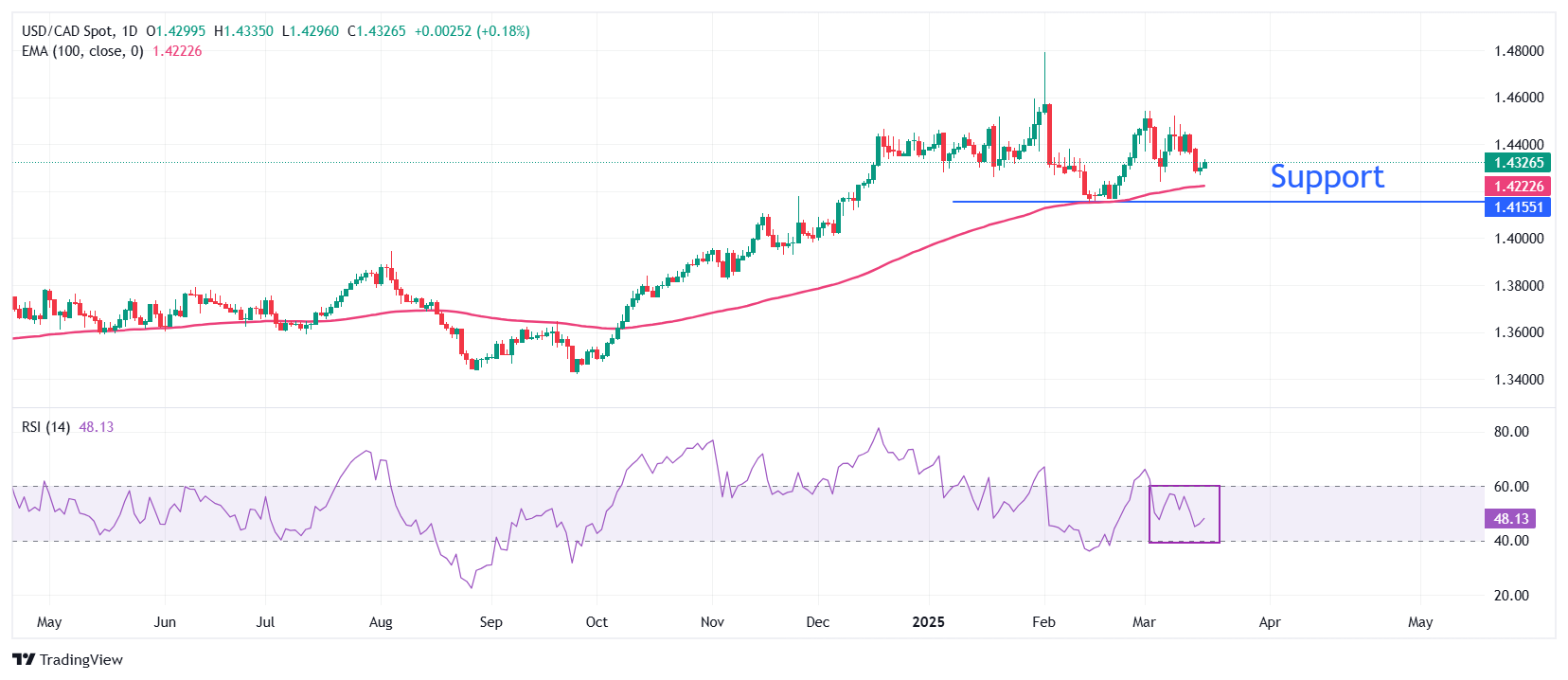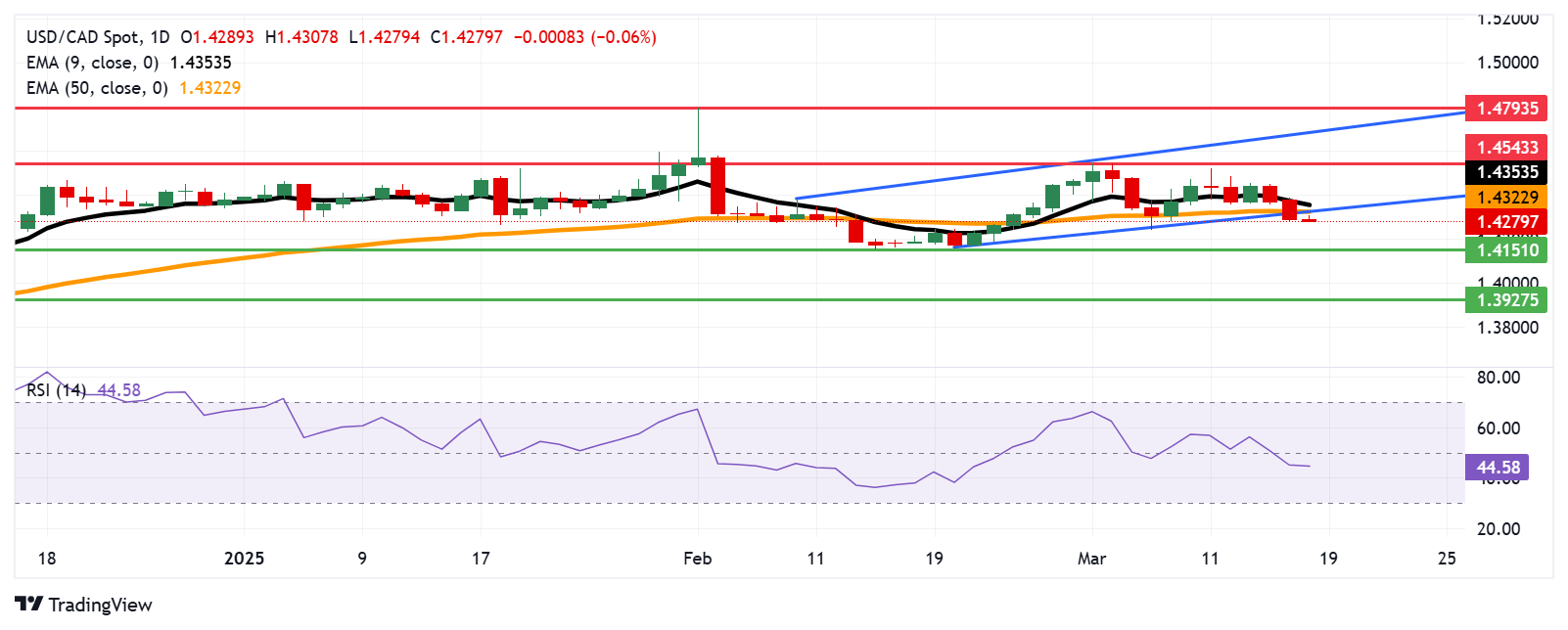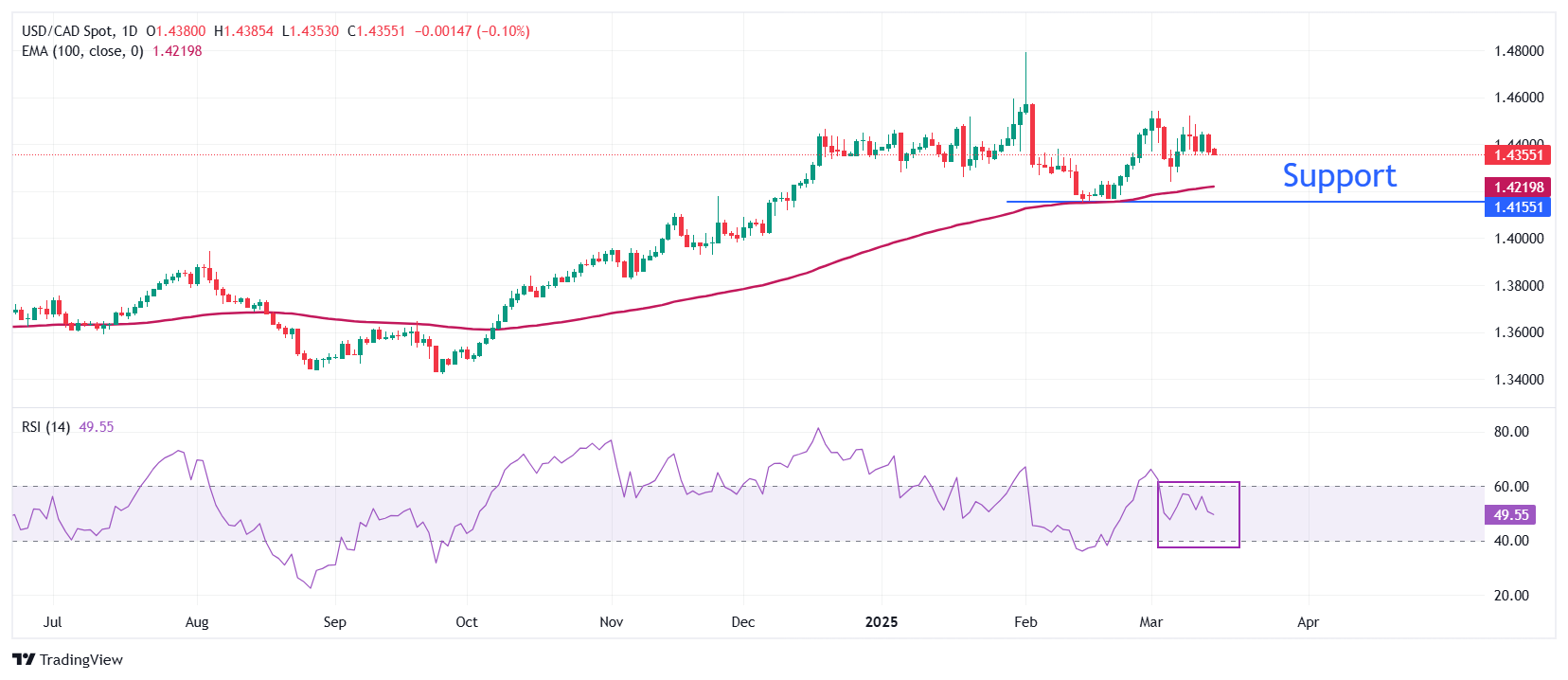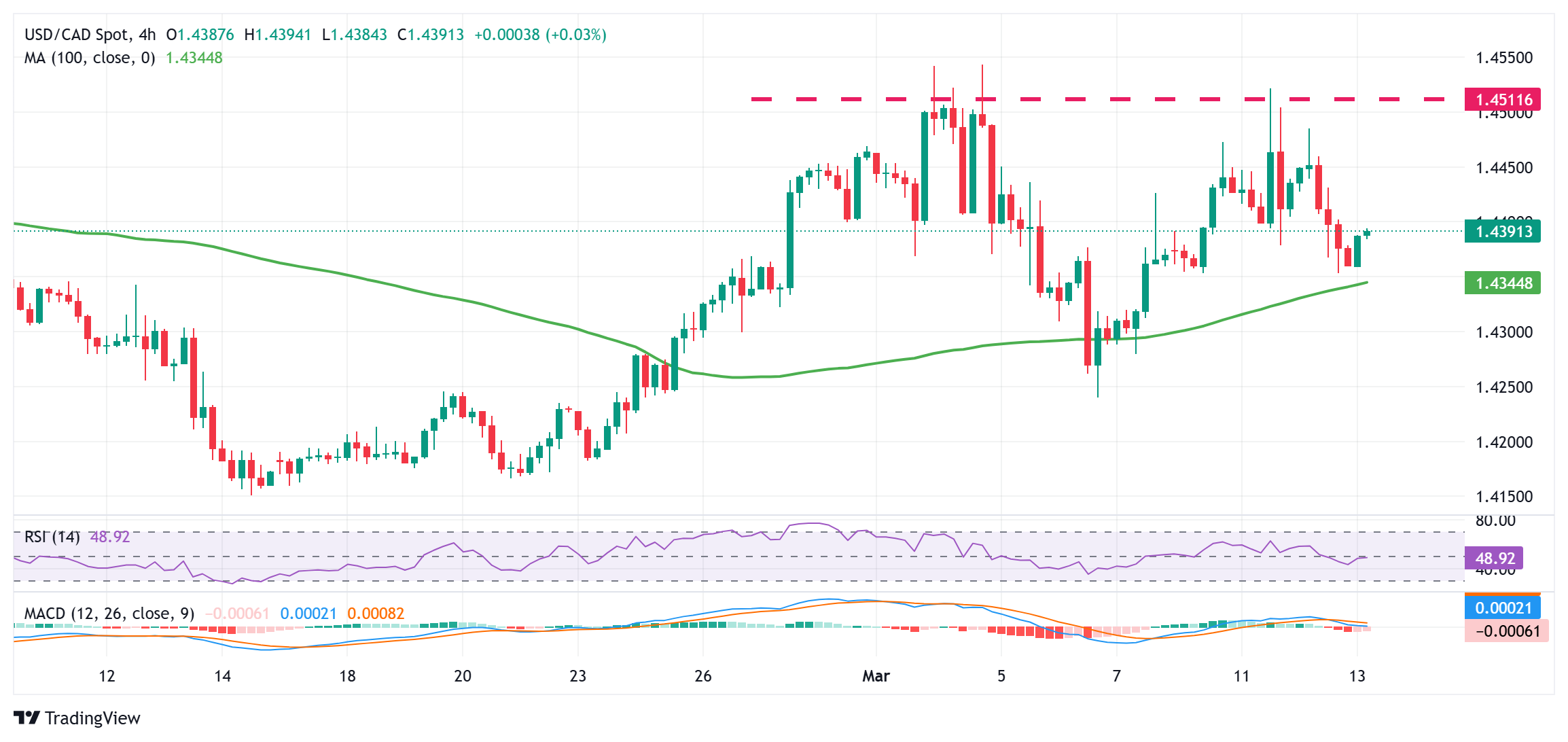- Analytics
- News and Tools
- Quotes
- Chart and quotes for USDCAD
CFD Trading Rate US Dollar vs Canadian Dollar (USDCAD)
| Date | Rate | Change |
|---|
Related news
-
19.03.2025 23:15USD/CAD edges higher above 1.4300 as Fed holds rates steady, eyes on BoC’s Macklem speech
- USD/CAD gains ground to around 1.4320 in Wednesday’s late American session.
- The Fed kept its benchmark federal funds rate in a range of 4.25%-4.5% at its March meeting on Wednesday.
- Traders brace for the BoC's Governor Macklem speech.
The USD/CAD pair gathers strength to around 1.4320 during the late American session on Wednesday. The Greenback edges higher against the Canadian Dollar (CAD) as the Federal Reserve (Fed) held the interest rate steady at the March meeting, as expected. The Bank of Canada (BoC) Governor Tiff Macklem is scheduled to speak later on Thursday about tariff-related uncertainty.
The US central bank decided to hold its benchmark interest rate steady for a second straight meeting on Wednesday amid mounting concerns that the economy is slowing and inflation could remain stubbornly high. Fed Chair Jerome Powell emphasized the high degree of uncertainty from US President Donald Trump’s significant policy changes, adding that the Fed officials can wait for more clarity on the impact of those policies on the economy before acting.
New economic projections indicated that Fed officials marked down their forecasts for growth this year, but they still see another half percentage point of rate cuts through 2025. The more hawkish remarks from Fed officials on rates from December provide some support to the US Dollar (USD) broadly.
On the other hand, a rebound in Crude Oil prices amid the rising geopolitical tensions in the Middle East could boost the commodity-linked Loonie and create a headwind for USD/CAD. It’s worth noting that Canada is the largest oil exporter to the United States (US), and higher crude oil prices tend to have a positive impact on the CAD value.Canadian Dollar FAQs
The key factors driving the Canadian Dollar (CAD) are the level of interest rates set by the Bank of Canada (BoC), the price of Oil, Canada’s largest export, the health of its economy, inflation and the Trade Balance, which is the difference between the value of Canada’s exports versus its imports. Other factors include market sentiment – whether investors are taking on more risky assets (risk-on) or seeking safe-havens (risk-off) – with risk-on being CAD-positive. As its largest trading partner, the health of the US economy is also a key factor influencing the Canadian Dollar.
The Bank of Canada (BoC) has a significant influence on the Canadian Dollar by setting the level of interest rates that banks can lend to one another. This influences the level of interest rates for everyone. The main goal of the BoC is to maintain inflation at 1-3% by adjusting interest rates up or down. Relatively higher interest rates tend to be positive for the CAD. The Bank of Canada can also use quantitative easing and tightening to influence credit conditions, with the former CAD-negative and the latter CAD-positive.
The price of Oil is a key factor impacting the value of the Canadian Dollar. Petroleum is Canada’s biggest export, so Oil price tends to have an immediate impact on the CAD value. Generally, if Oil price rises CAD also goes up, as aggregate demand for the currency increases. The opposite is the case if the price of Oil falls. Higher Oil prices also tend to result in a greater likelihood of a positive Trade Balance, which is also supportive of the CAD.
While inflation had always traditionally been thought of as a negative factor for a currency since it lowers the value of money, the opposite has actually been the case in modern times with the relaxation of cross-border capital controls. Higher inflation tends to lead central banks to put up interest rates which attracts more capital inflows from global investors seeking a lucrative place to keep their money. This increases demand for the local currency, which in Canada’s case is the Canadian Dollar.
Macroeconomic data releases gauge the health of the economy and can have an impact on the Canadian Dollar. Indicators such as GDP, Manufacturing and Services PMIs, employment, and consumer sentiment surveys can all influence the direction of the CAD. A strong economy is good for the Canadian Dollar. Not only does it attract more foreign investment but it may encourage the Bank of Canada to put up interest rates, leading to a stronger currency. If economic data is weak, however, the CAD is likely to fall.
-
19.03.2025 11:23USD/CAD Price Forecast: Holds key 1.4300 level ahead of Fed’s monetary policy decision
-
19.03.2025 10:50USD/CAD holds high above 1.4247 – ING
-
19.03.2025 05:28USD/CAD moves away from two-week low set on Tuesday, retakes 1.4300 ahead of Fed
-
18.03.2025 23:01USD/CAD remains weak below 1.4300 ahead of Fed rate decision
-
18.03.2025 13:12USD/CAD trades cautiously below 1.4300 after hotter-than-expected Canadian inflation report
-
18.03.2025 09:41USD/CAD: Further uptrend above 1.4550 – Société Générale
-
18.03.2025 08:24USD/CAD Price Forecast: Falls toward 1.4250 after breaking below a crucial support zone
-
18.03.2025 02:36USD/CAD trades with positive bias around 1.4300; upside seems limited ahead of Canadian CPI
-
17.03.2025 23:11USD/CAD remains on the defensive below 1.4300, Canadian CPI data in focus
-
17.03.2025 10:35USD/CAD Price Forecast: Trades cautiously near 1.4350 as Fed policy takes centre stage
-
17.03.2025 03:11USD/CAD holds steady above mid-1.4300s; seems vulnerable amid bearish USD
-
14.03.2025 05:01USD/CAD Price Forecast: Remains depressed around 1.4430-1.4425; downside seems limited
-
13.03.2025 23:02USD/CAD holds below 1.4450 amid trade uncertainty
-
13.03.2025 11:09USD/CAD to trend down towards the 1.41 level in the short-term – Danske Bank
-
13.03.2025 10:51USD/CAD: BOC cuts the policy 25bps to 2.75% – BBH
-
13.03.2025 10:45USD/CAD trades cautiously near 1.4360 despite US Dollar gets temporary relief
-
13.03.2025 05:31USD/CAD Price Forecast: Advances to 1.4400 neighborhood; lacks bullish conviction
-
12.03.2025 22:56USD/CAD softens to near 1.4350 after softer US CPI data, BoC cuts interest rate
-
12.03.2025 14:36USD/CAD gauges temporary support near 1.4400 after US CPI, BoC’s policy decision
© 2000-2025. All rights reserved.
This site is managed by Teletrade D.J. LLC 2351 LLC 2022 (Euro House, Richmond Hill Road, Kingstown, VC0100, St. Vincent and the Grenadines).
The information on this website is for informational purposes only and does not constitute any investment advice.
The company does not serve or provide services to customers who are residents of the US, Canada, Iran, The Democratic People's Republic of Korea, Yemen and FATF blacklisted countries.
Making transactions on financial markets with marginal financial instruments opens up wide possibilities and allows investors who are willing to take risks to earn high profits, carrying a potentially high risk of losses at the same time. Therefore you should responsibly approach the issue of choosing the appropriate investment strategy, taking the available resources into account, before starting trading.
Use of the information: full or partial use of materials from this website must always be referenced to TeleTrade as the source of information. Use of the materials on the Internet must be accompanied by a hyperlink to teletrade.org. Automatic import of materials and information from this website is prohibited.
Please contact our PR department if you have any questions or need assistance at pr@teletrade.global.




















